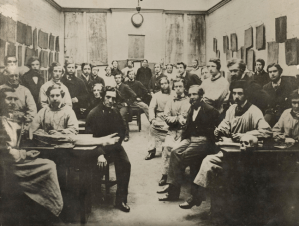Why It Wasn’t Just Gray’s Anatomy
No, not the TV show, the anatomy textbook. Known far and wide as Gray’s Anatomy, and still published today by Elsevier, Henry Gray could not have found success without his artistic partner, Henry Carter. Here’s their story.
Henry Vandyke Carter had been keeping a diary since he was fourteen. He was now twenty-four and an anatomy instructor at Saint George’s Hospital Medical School in London. He had been lamenting in the fall of 1855 about an indifference he had been feeling about his work and faith. “Very little irritability,” he wrote, “and still lament this disintegration of purpose, and act as much in regard to religion as to study. This latter troubles me very much, for I am doing nothing—nothing worth[while] and so this faltering.”
Carter might have still been troubled when he was approached a few weeks later by another anatomy instructor at Saint George’s, Henry Gray, who proposed a joint writing project. Carter had worked previously with Gray on a book about the spleen, with Gray describing the organ and Carter creating the illustrations. Carter possessed considerable talent as an artist, a trait no doubt passed along from his father, Henry Barlow Carter, a marine artist of some repute. Carter had been teaching alongside Gray for some time but considered the man a “snob.” Carter had been paid a pittance for his spleen illustrations, so he probably listened with a skeptical ear as Gray outlined his new, far more ambitious plan.

Carter described the discussion this way: “Little to record. Gray made proposal to assist by drawings in bringing out a Manual of Anatomy for students: a good idea but did not come to any plan.” Carter considered the idea “too exacting.” Gray persisted in courting the illustrator, however, and Carter, who needed money, finally relented. Carter drew the first few illustrations on paper, a process so cumbersome and time-consuming that he switched to drawing reverse images on woodblock. Gray for his part provided clear, precise, and exhaustive descriptions of individual body parts. Consider this unusually brief (for Gray) description of the middle fossa, a butterfly-shaped depression at the base of the skull:
The Middle Fossa, somewhat deeper than the preceding, is narrow in the middle, and becomes wider as it expands laterally. It is bounded in front by the posterior margin of the lesser wing of the sphenoid, the anterior clinoid process, and the anterior margin of the optic groove; behind, by the petrous portion of the temporal, and basilar suture; externally, by the squamous portion of the temporal, and anterior inferior angle of the parietal bone, and is separated from its fellow by the sella turcica. It is traversed by four sutures, the squamous, spheno-parietal, spheno-temporal, and petro-sphenoidal.
Three years later Anatomy: Anatomy Descriptive and Surgical, was published, a volume with a deep, burnt sienna cover that would almost immediately become a bestseller throughout Europe. The book, that “too exacting” an idea, contained three hundred and sixty-three of Carter’s illustrations, each one meticulously detailed and rich in labeled parts. The anatomy texts of the time, particularly Quain’s Anatomy, couldn’t compete with Gray’s Anatomy, which offered larger pages, better organization, and far fewer cross references, which Quain’s had infused throughout.
On publication the Lancet wrote, “[The book] is a work of no ordinary labour, and demanded the highest accomplishments, both as anatomist and surgeon, for its successful completion. We may say with truth, that there is not a treatise in any language, in which the relations of anatomy and surgery are so clearly and fully shown.” Initial sales were so healthy that a second edition was planned almost immediately and published in 1860. In the intervening year renowned Philadelphia publishing house Blanchard and Lea (later Lea and Febiger) published a version for the United States, and that too became a bestseller.
Anatomy was renamed in 1938 to Gray’s Anatomy and is more commonly known today as simply Gray’s. The text has been in continuous publication for more than 165 years, mushrooming over that time from an initial six by nine inches to nine by twelve, from 782 pages to an enormous 1,606 pages, from just over three pounds to more than ten, and from about $5 in 1860 to more than $240 in 2023.
Together Gray and Carter produced a work of extraordinary consequence. Hundreds of thousands of medical students the world over have used Gray’s as an intimate part of their education and subsequent practice. Even today Gray’s can be found in virtually any college or university library and remains a foundational resource for human anatomy education. “Gray’s Anatomy is so well known today,” wrote Ruth Richardson in The Making of Mr. Gray’s Anatomy, “that it’s hard to imagine a time when it didn’t exist: that is, before its text had been written, before its famous illustrations had been drawn, before the contract with its publisher had even been agreed.”
Tragically, Carter perished from tuberculosis in 1897. He had lived a difficult life, and his name had only belatedly been added to the authorship of the textbook that changed medical education. Gray had been caring for his 10-year-old nephew with smallpox and also contracted the disease. His nephew recovered, but Gray did not. He died in 1861 at age 34.







